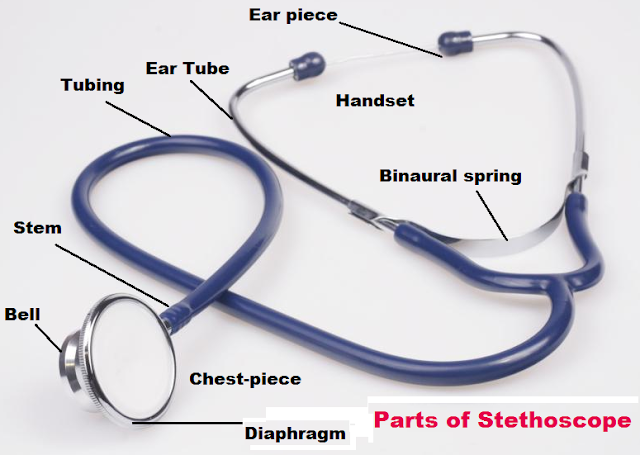Stethoscope Medical Device
Stethoscopes are a vital tool or medical
instrument for listening to sounds produced within the body, chiefly in the
heart sound, breathing, lungs, or abdomen.
A stethoscope device is also used with a
manual sphygmomanometer to measure blood pressure.
Check out here to
know the blood
pressure range.
Parts of Stethoscope and Functions
A medical stethoscope has three main parts as; an earpiece, a
tube, and a chest piece.
A stethoscope is made up of chestpiece, diaphragm and/or bell,
stem, tubing, headset, ear tubes, and ear tips.

1. Chestpiece: Head of the stethoscope
The chest piece is known as the head of the stethoscope. The chest piece/ head of the stethoscope has a connected stem, diaphragm, and/or bell.
The chest piece part of the stethoscope is placed on the patient's skin and is responsible for conducting sound.
2. Diaphragm
The diaphragm of
the stethoscope is the large circular end of the chest piece.
The diaphragm of the device
allows listening to an area of the patient’s body and picks up higher frequency
sounds.
3. Bell
The bell of the stethoscope is the smaller circular end of the chest piece.
Bell side of the
device focuses on a narrower range of listens for lower-frequency sounds that
may not easily be detected by the diaphragm.
The bell of the stethoscope is most effective at transmitting
lower frequency sounds, while the diaphragm of the stethoscope is most effective at transmitting higher frequency sounds.
Check out here what are vital
signs or cardinal signs.
4. Stem
The stem of a
stethoscope is basically the metal /steel part of the stethoscope that connects
the tubing of the stethoscope to the chest piece.
On stethoscopes
with two-sided chest pieces, the stem of the device allows users to switch between
the diaphragm and bell by turning the chest piece.
By rotating the
stem, the diaphragm is open to the acoustic path of relating to the sound of an
organ/ body.
5. Tubing
The soft flexible
line of the stethoscope is known as stethoscope tubing.
The function of the
tubing of the device is to maintain and transfer the frequency or sound level, that
is captured by the diaphragm or bell and sent it to the ear tubes.
Stethoscope tubing
connects to the metal/steel ear tubes.
6. Headset, Eartubes, and Eartips
The headset is the
combined components of the upper half of the stethoscope which include the ear
tubes, tension springs, and Earpieces.
The headset of a
stethoscope has two ear tubes.
Earpieces consist of small
round tips on the ends of the ear tubes that fit into the ears.
Earpieces of the device
allow sound to flow efficiently into the ear canal.
Types of Stethoscope
Following are different types
of stethoscopes -
1. Acoustic Stethoscopes
Acoustic stethoscopes contain
two ear tubes, which are connected to a chest piece and work through the
transmission of sound.
The chest piece transmits
sounds of organs through both the ear tubes.
2. Electronic Stethoscope
Electronic stethoscopes
categories are –
a. Amplifying stethoscope
Amplified stethoscopes refer
to battery-operated, electronic stethoscopes specifically designed to amplify
body sounds.
b. Digitizing stethoscope
The digital stethoscope is able to convert an acoustic sound
to electronic signals/
digital signals, later which can be amplified
for optimal listening.
3. Recording Stethoscope
Recording Stethoscope is enabling
to record heart sounds or lung sounds.
4. Fetal Stethoscope
The fetal stethoscope is used for
fetus, it is an acoustic stethoscope that is used to listen to the sounds of
the fetus.
5. Doppler Stethoscope
Doppler stethoscopes are used
to measure the Doppler effect of ultrasound waves reflected from the
various parts of the body.
This stethoscope device detects the motion of
parts by detecting the change in frequencies.
For example,
The beating of the heart
Flow of blood
6. Disposable Stethoscope
A disposable Stethoscope is
used for a single-patient stethoscope. It is a recommended isolation patient,
used in infection control locations, burn units, and PPE environments.
Know what parts
of thermometer are and how to disinfect the thermometer?
Use of Stethoscope
A stethoscope can be used
to listen to the sounds of a body organ. Such as sound made by the heart,
lungs, intestines, and blood flow in arteries and veins.
In combination with a manual
sphygmomanometer, the stethoscope is used for measuring blood pressure.
Check out here parts
of Sphygmomanometer.
Stethoscopes work by, sounds move through the
stethoscope tubing and into the ear tubes, where the health professionals hear
the patient's heartbeat, lung, and abdominal sounds.
Major Use of Stethoscope
The
major use of stethoscope is-
1. To determine lung sounds
2. To detect heart sounds
3. Bowel sounds can be
measured
4. Used to calculate blood
pressure
5. Used to blood flow in
arteries and vein







0 Comments